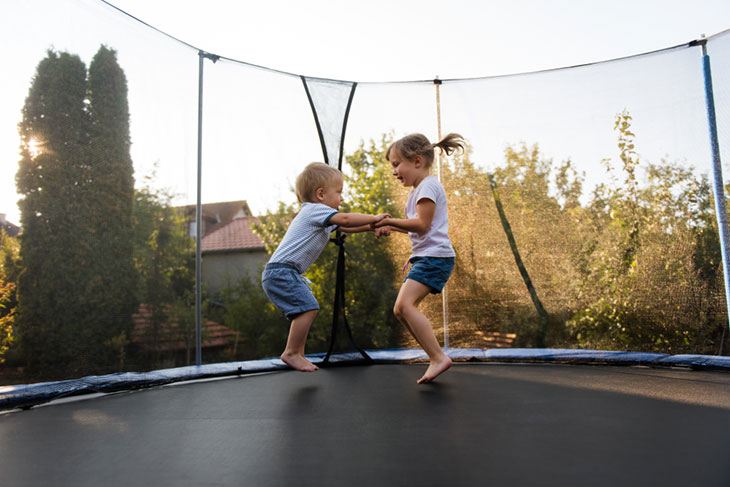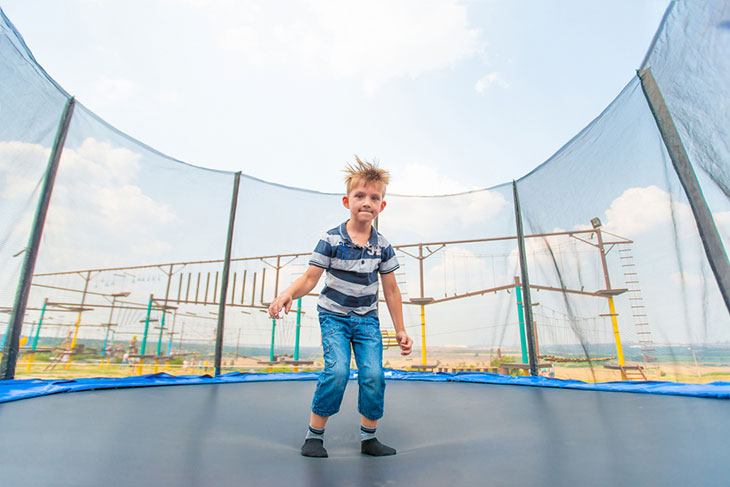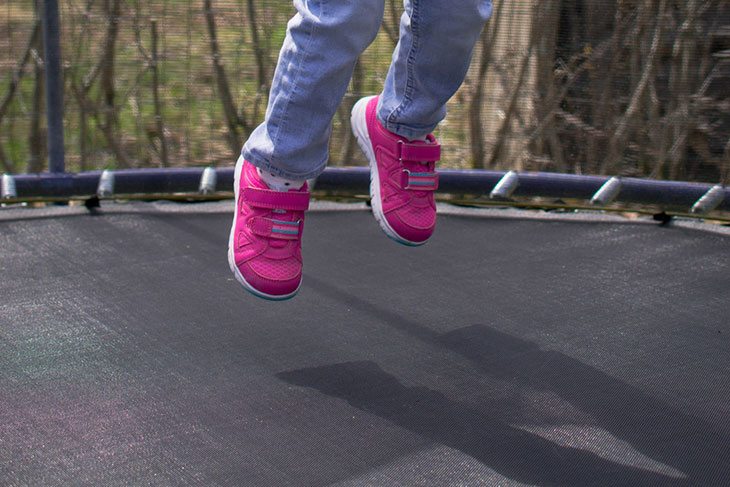It’s probably time to start planning and thinking about activities you can do during the summer as the pandemic is drawing to an end. For many of you, this means you’ll go on a vacation to a place near the beach or relax in the countryside. But, this doesn’t offer much physical activity, which is where trampolines jump in.
The following guide will tackle the notion of trampoline measurement, which is something you’ll need if you’re buying a new one or if you’re purchasing spare parts and you need the exact measurement for the replacement. Either way, we’ll help you work your way around and learn a new skill along the way.
Stay tuned!
More...
Learning The Basics
Before we go in-depth about measurements, you should first know what the essential parts of a trampoline are and what is there to measure.
There are some accessories that you shouldn’t worry about, so we’ll go over the main components and talk more about what they are and their purpose.
1. Trampoline Frame

The essential piece of every trampoline is the frame. It is what holds the entire trampoline together, and it is used for two purposes. The first one is to balance out the entire structure and give the trampoline its weight.
Secondly, each spring trampoline has a set of stainless springs that are connected to the jumping mat via the frame. The important thing to remember if you’re purchasing a new trampoline is that you’ll need to get a solid frame that has a proper weight that can hold the entire structure together.
There are some heavy-duty models that weigh a lot more, but that shouldn’t be your focus if you’re buying a trampoline for some outdoor fun.
2. Trampoline Springs
As we mentioned, trampoline springs serve as connectors between the frame and the jumping mat. They are able to stretch, and they essentially give the bounce to the trampoline. Of course, there are other factors that affect the intensity of the bounce, but springs are the main culprits.
One of the common problems with trampolines is that springs either stretch too much or wear out in time, which is why it is vital to purchase a trampoline with quality springs.
We recommend looking at trampolines that have galvanized steel springs or at least stainless steel ones. The galvanized ones are non-corrosive and can sustain a lot of pressure over time, while some other trampoline manufacturers often include standard metallic springs that last approximately a year.
3. Safety Enclosure Net

This is another accessory you’ll want to know about since it’ll also require some measuring if you’re purchasing a new one or replacing an older model. The most important features of an enclosure net are durability and overall safety.
Since nets cover up the trampoline a few feet above the average height of an adult, it’s nearly impossible to fall out while jumping. However, that doesn’t mean it cannot tear from weight pressure if you fall on it. Therefore, you’ll need to purchase a net with quality stitching, preferably with multiple rows.
Secondly, it’s also essential that the net is UV-protected since it not only preserves its own lifespan but protects you from the sides from sun exposure. Finally, we recommend you buy a net made from polyethylene - a lightweight thermoplastic that has a lot of resilience to it.
4. Trampoline Poles
This is a no-brainer. Trampoline poles connect the safety enclosure net with the frame and give it much-needed stability, especially during windy days.
Basically, any pole will do, but it’s still important to get quality ones since they’ll probably be exposed to many environmental factors, such as rain, wind, and snow.
5. Trampoline Pad
Finally, the last thing you should know about is trampoline pads. They cover up the outer layer of the frame that has the springs. Obviously, it’s vital that they’re secured since you don’t want to risk any injuries by falling on the springs.
The best pads are usually made from PVC, but that isn’t enough since you’ll probably have a bad landing here and there that will require you to put your feet on the pad. Therefore, it’s best to look for a combination of PVC pads that have closed-cell foams inside. They’ll soften up your fall and decrease the risk of injuries significantly.
The Measuring Guide for All Components
1. Measuring The Frame

We should obviously start with the frame since it’s the most important part of a trampoline to measure. You’ll rarely replace the frame itself since they’re usually sturdy and don’t get damaged that easily, so this is more of a guide to help you if you’re buying a new one or simply knowing the measurements if you’re purchasing a new jumping mat.
The process is simple and straightforward and shouldn’t last more than a couple of minutes. You’ll need a measuring tape, and you’ll stretch it across the entire trampoline twice - horizontally and vertically. The best way to do it is to imagine the frame as a clock and stretch it from 12 to 6 and then again from 3 to 9.
Then, with a little bit of math, you’ll add the measurements and divide them by two and get the final result. It’s vital to remember that you do this from the outer edges of the pad and not the inner ones. Also, if the calculation is not round and you’re missing an inch or two, you can round it up since the replacement frame will fit the difference.
Also, this is the measurement guide for a round trampoline. The process for rectangle trampolines is even easier since you know exactly what to measure. Again, remember to do it from the outer edges, and you’re good to go.
2. Measuring The Springs
Springs are the second thing that you should measure, and it’s a really straightforward measurement. If you take a look at your springs carefully, you’ll see that they are spiral objects with two hooks at the ends, where the wider hook goes in the trampoline, and the other hook connects to the frame.
A common misconception is that hooks aren’t included in the measurement of a spring, which is wrong. You should take a measuring tape and measure it from the very end of one hook to the other. Also, it’s best to use two or three springs and calculate the average since some can get stretched and others can remain unimpacted.
The trick to knowing if your spring is stretched is by trying to push a piece of paper between the spirals. If the paper can fit, the spring is stretched more than normal.
3. Measuring The Safety Net

Measuring the net itself is not something you should do for a very simple reason - there’s no need to. Safety nets are universal, and they are sold according to the frame diameter of your trampoline.
If you complete the first step and know the diameter of your frame, the only thing you have to do is count the poles, and you’ll easily find a net that works for you. Remember to look for nets that have good protection and stitching, and that’s it.
4. Measuring The Poles
A similar thing goes for trampoline poles. If you browse through Amazon or other sites that offer trampoline gear, you’ll usually find that poles are either sold for 8-foot trampolines or larger models, such as 12 and 14-foot ones.
They’re also universal, so the only thing to know is the frame diameter and whether the net in question has good quality or not.
5. Measuring The Pads
If you complete the first step, you already have the measurements for your next pad. If the final measure is a few inches off; for example, your trampoline frame measures 9 foot and 10 inches, you can buy a 10-foot pad, and it’ll fit the frame.
All of these guides are simple, and there’s really no need to call someone or go through the trampoline manuals that you received in the package. All you’ll need is really a measuring tape and 15 minutes of your time.
If there’s something that you’re not sure about, write to us in the comments, and we’ll make sure to respond to you in the quickest manner.
Final Thoughts - Summary
Before we finish, we just want to note a couple of small details. First off, this is a how to measure a trampoline guide for round models that you can find almost anywhere online. Secondly, this is not something you’ll need an expert for since everyone can do it.
Finally, we hope that you learned more about trampolines, in general, and that you’ve mastered the skill of trampoline measurement.
Also, use this opportunity to look around these accessories and see how trampolines really work.
My name is Larry Dunn from Dallas Texas and I have a deep passion and love for the trampoline.
With many years of experience in the field of healthcare service, I have decided to start his own website which is about a trampoline.
With this website, I will share his experiences and expertise advices on different factors to consider when deciding whether or not a trampoline is safe for you and your family.
